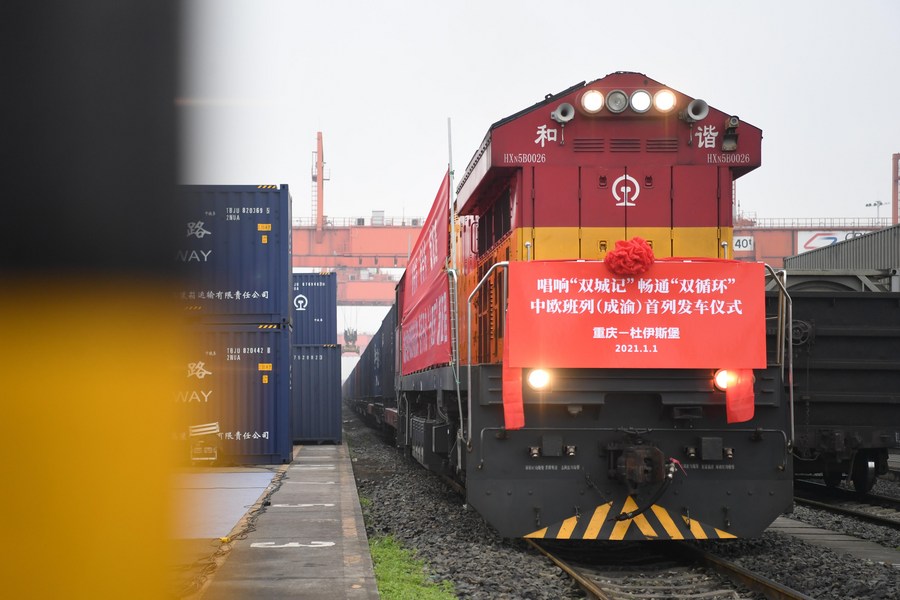
A China-Europe freight train bound for Duisburg of Germany prepares for departure at Tuanjiecun Station in southwest China's Chongqing, Jan. 1, 2021. (Xinhua/Tang Yi)
BRUSSELS, Dec. 25 (Xinhua) -- It may not be unusual for people in Europe to come across the idea of the Belt and Road Initiative (BRI) on news media, but it is highly likely that few have a clear idea about how the grand initiative is changing their lives.
LONGTIME PAIN IN THE NECK
An epic itinerary for holiday goers in Croatia is a drive along the coastline.
Along the picturesque hillside road beside the Adriatic Sea, the drive can take one to most of the hotspot towns such as Zadar, Split and Dubrovnik, a must-go especially for Game of Thrones fans.
The journey can be satisfying except for one nuisance -- expect to wait in the car for hours under the scorching sun because of a border check.
The coastline of Croatia is cut off between the towns of Ploce and Dubrovnik by a narrow land of Bosnia and Herzegovina, where border check points are set up. Travelers to Dubrovnik by land have to pass two check points, one at each end of the 20-km-long road.
For ages, this severed part of land has been a pain in the neck for people in Croatia, which has long desired erecting a bridge over the sea to close the gap.
A DAUNTING PROJECT
In 2007, Croatia started to build the bridge but had to leave it unfinished due to a shortfall of funds in 2012.
After nearly four years of construction, several piers were left in the water and the bridge was still nowhere in sight.
Croatia never gave up the project. After it became a member of the European Union in 2013, Croatia tapped EU fund for the bridge. With an investment of over 400 million euros (453 million U.S. dollars), Croatia revived the project.
Coincidentally, China launched in the same year an initiative to bridge infrastructure gaps in countries across the Asia-Pacific region, Africa and Central and Eastern Europe aimed at boosting economic growth and promoting shared prosperity through cooperation. The initiative is now widely known as the BRI.
Afterwards, a wide range of countries benefited from the initiative with new roads, ports and bridges built.
In 2018, the China Road and Bridge Corporation along with other Chinese companies won the bid for the 2.44-km-long sea-crossing bridge.
On July 28, the Croatian lands which used to be divided were connected together for the first time after the last missing part of the bridge was put into place.
It took the Chinese companies three years to piece the bridge together. It now takes minutes to drive from one end of the bridge to the other.
SILENT CONTRIBUTOR
While the bridge will vastly improve travel in Croatia, other BRI projects are saving lives in Europe.
It wasn't long ago when Europeans were scrambling for masks, surgical gowns and other protective gear at the start of the COVID-19 pandemic. When sea freight was disrupted due to backlogs at ports and air freight was severely cut at the peak of the pandemic, the China-Europe freight rail provided a much-needed lifeline.
Covering over 170 cities in more than 20 European countries, the China-Europe freight trains have brought in hundreds of thousands tons of medical supplies including masks, surgical gowns and other necessities to Europe.
MAKING EUROPE GREENER
Chinese companies involved in the BRI have never hesitated to bring their state-of-the-art technology to countries that need it most. In some European countries, Chinese companies are playing a proactive role in helping local economies become greener.
Shanghai Electric Power Company has taken on the ambitious task of turning the Gozo Island of Malta into a carbon neutral territory in the country.
Through years of cooperation with local partners since 2014, the company brought its expertise to Malta, overhauling and upgrading the power grid in the country and making frequent blackouts a thing of the past.
Given the EU's pledge for carbon neutrality by 2050, member countries including Malta have begun to take action to reduce emissions.
By installing an energy storage system on Gozo, Shanghai Electric plans to transfer the electricity yielded by solar power and wind power stations to the system and make it carbon neutral. It is the first "carbon neutral" energy storage system in the country.
Meanwhile, Chinese electric vehicle company Nio is witnessing a growing popularity with its products in Norway, launching its first model ES8 in the Nordic country on Sept. 30.
Gunnar Birkenfelter, founder of a car-sharing company in Norway, wasted no time adding the ES8 to his fleet. He said roughly 10 percent of his company's cars are of Chinese brands.
Birkenfelter said Chinese automotive brands were of high quality and he wouldn't hesitate to recommend them.
Nio has committed itself to Norwegian market with a plan to install four battery swap stations in 2021 and more in the future.
The scale of the BRI's involvement in Europe continues to deepen, with Chinese investors and their local partners closely collaborating across a variety of sectors. The BRI will ignite enormous change on the continent over time and impact the lives of Europeans for years to come. Enditem



